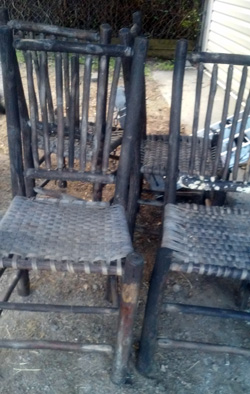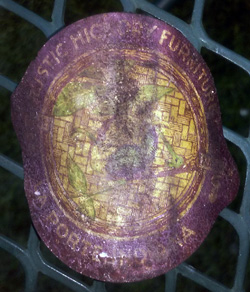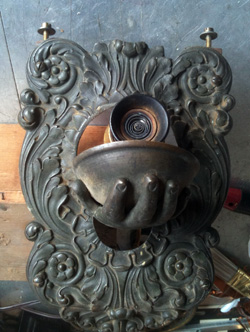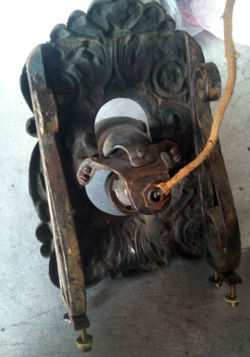 |
|
|||
 |
 |
|||
Copyright © Harry Rinker, LLC 2015 Questions
and Answers
ANSWER: If your husband likes to watch money go up in smoke, he should stop reading at this point and burn them. The rustic table and chairs, clearly heavily used and in need of some repair, fall into the “too good to throw out” category. You have money in the bank. The only question is to find the right bank to make the deposit. A “rustic” craze began in the later Victorian era and lasted through the 1920s. Individuals fled the stale air of urban areas to vacation in the clear, crisp air of the mountains. Many stayed at resorts. Others bought land and built a “primitive” cabin or cottage. Victorians living in a residence with a tree-filled backyard constructed walking paths through the woods. An occasional grotto filled with rustic furniture designed to encourage a thoughtful contemplation of nature’s bounties adorned the pathway. Many rustic cottages and walks were decorated with hickory furniture, much of which originated in Indiana. There were six major manufacturers: (1) Old Hickory Furniture Company, Martinsville; (2) Rustic Hickory Furniture Company, LaPorte; (3) Indiana Hickory Furniture Company, Colfax; (4) Columbus Hickory Furniture Company, Bedford: (5) Indiana State Farm Industries, Putnamville; and (6) Indiana Willow Company, Martinsville. Although collectors favor examples made by the Old Hickory Furniture Company, they willingly buy any examples with a maker’s label. When sets are encountered, such as your table and chairs, collectors consider this a bonus.
Companies copied each other’s designs, thus making it difficult to identify the manufacturer of rustic hickory furniture without a label. Ralph Kyle’s “A History of the Old Hickory Chair Company and Indiana Hickory Furniture Movement,” published by the author in 1995, is the leading reference guide on the subject. Also see the following website: http://www.cherrygallery.com/journal/defining-and-identifying-old-hickory-vs-hickory-furniture/. Hickory furniture is part of the Adirondack/Cabin/Cottage/Hunting-Fishing/ Lake/Rustic Outdoor Look that experienced a 1990s collecting and decorating renaissance that still continues. While maker plays a secondary role in pricing, value is contingent first on condition, second on the scarcity of the piece(s) [tables and chairs are among the most commonly found forms], third aesthetics, and, finally, desirability. Advanced collectors can identify manufacturers without the aid of stamps and labels. The survival of the label on your chairs is a value plus. Midwest antiques shows often feature one or more specialized dealers in the rustic/cabin look. One such dealer is Robert A. Markey, owner of Christiby’s in Traverse City, Michigan. Christiby’s specializes in the Outdoor Look. Unfortunately, Markey does not have a website or Facebook page. I do have an email address, markeycom@charter.net and a phone number (231) 947-5906 if you wish to contact him. You did not provide information in your email indicating the size of the table and how many chairs you had. The photograph attached to your email showed two chairs. No mention was made of condition. Based on a quick inspection of the chairs and assuming you have a set of four, the minimum value for your Rustic Hickory Furniture table and chair set is between $300.00 and $350.00. QUESTION: I have my grandfather’s World War I uniform including his wool campaign hat, wool gloves, belt, and leg wrappings. I do not have his felt hat and boots. He would have worn them until all the wear was gone. He was very thrifty. In addition, I have a razor kit issued by the Army. It has all the pieces – case, polished steel mirror, razor with screws, and double edged blade. I had a nice straight razor that my grandfather acquired in France but sold it to a local barber that collects straight razors. Finally, I have his 1918 journal. Hence, I know he shipped out on Friday June 22, 1918. I also have journals from 1911, 1912, and other random years. What is the collection worth? – JT, Ranchester, WY, Email Question. ANSWER: There are some unanswered questions that impact the value of what you have: (1) do have his enlistment, discharge, and other military papers; (2) do you have a picture of your grandfather in uniform; (3) does the uniform have his division patch and service medals; and (4) what is the overall condition of the material? These are important because each adds to the potential value of the collection. Since the uniform and other material belonged to your grandfather, you know the name of the individual who wore them. Without a photograph or other documentation, it is your word against the world. The 1918 diary is a major source to solidify the provenance of the material. The success of the safety razor is connected to World War I. King C. Gillette obtained his patent for a safety razor on November 16, 1904. Production began in 1903. Gillette convinced the United States Armed Forces to distribute his safety razor to all US personnel serving in World War I. By 1919, the total amounted to 3.5 million razors and 32 million blades. When soldiers and other wartime personnel returned home, they continued to use the Gillette safety razor and blades. Collector interest in diaries and other personal papers has increased over the past decade. During the recent Paper Ephemera seminar at the Institute for Antiques and Collectibles’ 2015 Antiques and Collectibles Summer Camp, Barb Jersey, owner of Wonder Woman Estate Sales in Michigan, confirmed that the selling price of diaries has more than doubled in the past few years. A diary with good content is now worth over $20.00. Content is critical to value. Wartime, frontline diaries are highly desirable. The value of your material as a unit, breaking it apart would decrease its value, is between $85.00 and $100.00. If you can answer the questions at the beginning of my answer positively, the value will increase.
ANSWER: Based on the design on the base and the electric cord that still is attached, I date the piece between 1890 and 1910. Staring in the late 1880s, bars and saloons, country stores, fraternal lodges, and other businesses used trade stimulators, countertop game of chance machines, as a means of encouraging trade. Some trade stimulators were slot machines. Payoff was in candy, cigarettes, cigars, and other goods. Those individuals winning a cigar often wanted to smoke it immediately. As a result, countertop cigar lighters arrived on the scene.The design of these countertop QUESTION: I have a Radio 4012 car made by the Thorens Music Box Company. The period box is in excellent condition. What can you tell me about it? – JC, Email Question ANSWER: Shuco, a toy company founded in 1912 by Heinrich Múller and Heinrich Schreyer, made two toys featuring a Thoren music box. “Radio” was applied to the two models because the music box could be turned on and off by a knob at the top of the car. The Schuco Radio 4012 was made in the U.S. Zone of Germany between 1952 and 1964. The car came in a variety of colors. Beige is the scarcest of the colors. On June 23, 2011, Ted Hake sold a red version of the Radio 4012 car in its period box for $206.64, which included a 15 percent buyer’s penalty. An eBay seller sold a blue version in April 22, 2015, for $286.90 plus $19.10 for shipping. An eBay seller asked $650.00 for a beige example. It might be scarce but not that scarce. His listing failed to attract a bid.Harry L. Rinker welcomes questions from readers about
collectibles, those mass-produced items from the twentieth and twenty-first centuries.
Selected letters will be answered in this column.
Harry cannot provide personal answers.
Photos and other material submitted cannot be
returned.
Send your questions to: Rinker on Collectibles, 5955 Mill
Point Court SE, Kentwood, MI 49512.
You also can e-mail your questions to
harrylrinker@aol.com.
Only e-mails containing a full name and mailing address
will be considered.
You can listen
and participate in
WHATCHA GOT?, Harry’s
antiques and collectibles radio call-in show, on Sunday mornings between 8:00 AM
and 10:00 AM Eastern Time.
If you
cannot find it on a station in your area,
WHATCHA GOT?
streams live on the Internet at www.gcnlive.com.
SELL, KEEP OR TOSS?: HOW TO DOWNSIZE A HOME,
SETTLE AN ESTATE, AND APPRAISE PERSONAL PROPERTY
(House of Collectibles, an imprint of Random House Information Group, $17.99),
Harry’s latest book, is available at your favorite bookstore and via
www.harryrinker.com.
|
||||
 QUESTION: I recently purchased a cottage in Northern Michigan that contained an old table and chair set. I noticed a paper tag on one of the chairs indicating that it was made by Rustic Hickory Furniture in Laporta, Indiana. Could you please provide me with the history of the table and chair set and its value before my husband puts them in the bonfire? – JF, Taylor, MI, Email Question
QUESTION: I recently purchased a cottage in Northern Michigan that contained an old table and chair set. I noticed a paper tag on one of the chairs indicating that it was made by Rustic Hickory Furniture in Laporta, Indiana. Could you please provide me with the history of the table and chair set and its value before my husband puts them in the bonfire? – JF, Taylor, MI, Email Question The Rustic Hickory Furniture Company began production in 1902 and ceased production in 1934. Rustic Hickory Furniture Company used two methods to mark its pieces. The first is a rectangular brand stamp that was burned into the wood. The second is a paper label.
The Rustic Hickory Furniture Company began production in 1902 and ceased production in 1934. Rustic Hickory Furniture Company used two methods to mark its pieces. The first is a rectangular brand stamp that was burned into the wood. The second is a paper label. QUESTION: I have an old cigar lighting device. The metal base has scalloped edges with an elaborate filigree floral design. In the center is an oval from which extends a human hand that holds a cup. In a circular tube just above the cup is an electric coil that when hot serves as the light source for a cigar. The two sides have “S” swirl supports. There are two screws on the bottom of each support to hold the cigar lighting device in place. When was it made, and what is its value? –CS, Hollidaysburg, PA, Email Question
QUESTION: I have an old cigar lighting device. The metal base has scalloped edges with an elaborate filigree floral design. In the center is an oval from which extends a human hand that holds a cup. In a circular tube just above the cup is an electric coil that when hot serves as the light source for a cigar. The two sides have “S” swirl supports. There are two screws on the bottom of each support to hold the cigar lighting device in place. When was it made, and what is its value? –CS, Hollidaysburg, PA, Email Question cigar lighters, which also might be found in a tobacconist shop, varied from plain to highly ornate figural machines. The value of your extended hand cigar lighter is between $150.00 and $175.00.Do not plug it in. Based on my analysis of the cord currently on the piece, you run the risk of fire or an unexpected jolt of electricity.
cigar lighters, which also might be found in a tobacconist shop, varied from plain to highly ornate figural machines. The value of your extended hand cigar lighter is between $150.00 and $175.00.Do not plug it in. Based on my analysis of the cord currently on the piece, you run the risk of fire or an unexpected jolt of electricity.